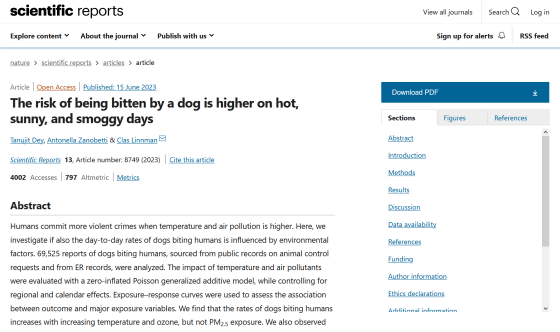Research results that the risk of being bitten by a dog increases on ``hot and smoggy sunny days''

It is known that human behavior is influenced by air quality and climate, and
The risk of being bitten by a dog is higher on hot, sunny, and smoggy days | Scientific Reports

Hot days, angry dogs: How environmental factors influence canine aggression
https://www.news-medical.net/news/20230619/Hot-days-angry-dogs-How-environmental-factors-influence-canine-aggression.aspx
Dog Bites More Common on Hot, Hazy Days
https://www.usnews.com/news/health-news/articles/2023-06-16/dog-bites-more-common-on-hot-hazy-days
Various animals, including humans, exhibit aggression to secure territory and resources to live on, and to protect themselves and their fellow members. Aggression toward others is triggered by prefrontal cortex control systems and triggering stimuli, and in humans is influenced by a variety of psychological and social factors, as well as external factors such as temperature and air quality. I know there is. Although it has been shown that the aggression of rhesus monkeys and rats increases as the temperature rises, there has been little research into the relationship between aggression and external factors in dogs, which are the animals most familiar to humans. That's right.
Therefore, a research team led by Tanujit Dey of Brigham and Women's Hospital , which belongs to Harvard Medical School, conducted research in eight American cities ( Dallas , Houston , Baltimore , Baton Rouge , Chicago , Louisville , Los Angeles ) from 2009 to 2018. The analysis was performed using data from 'dog biting cases' that occurred in New York .
The research team used PM2.5 and ozone concentration data published by the Environmental Protection Agency , as well as temperature, ultraviolet rays, and precipitation data published by the Oceanic and Atmospheric Administration to compare cases of dogs biting humans. Analyzed relationships.

The analysis found no relationship between PM2.5 concentrations in the air and dog aggression, but found that dogs bit humans 11% more often on days with high UV levels. In addition, it was found that the number of dogs biting humans increased by 4% on days with high temperatures, 3% on days when the atmospheric ozone concentration increased, and decreased by 1% on days with high precipitation.
Sensitivity analyzes also showed that the correlations between the incidence of dog-biting incidents and individual factors such as temperature, precipitation, ozone and UV levels were stable and not significantly affected by variance. . Since ozone is the main substance that makes up
Past studies have shown that the concentration of ozone affects human aggression, and research results that exposure to ultraviolet rays increase the secretion of steroid hormones related to aggression have also been shown. It is consistent with research results.
'We concluded that dog or human-canine interactions were more hostile on hot, sunny and smoggy days,' said the researchers. The burden also includes the cost of increased animal aggression.'

Related Posts:







